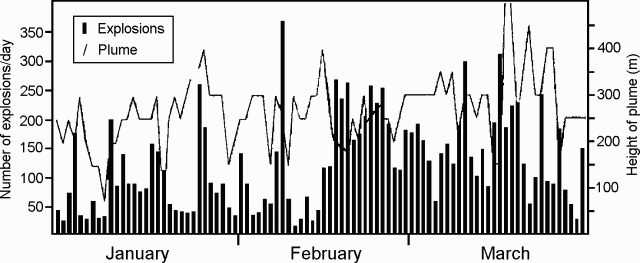Report on Krakatau (Indonesia) — March 1995
Bulletin of the Global Volcanism Network, vol. 20, no. 3 (March 1995)
Managing Editor: Richard Wunderman.
Krakatau (Indonesia) Explosions continue, sending ash plumes daily up to 500 m above the summit
Please cite this report as:
Global Volcanism Program, 1995. Report on Krakatau (Indonesia) (Wunderman, R., ed.). Bulletin of the Global Volcanism Network, 20:3. Smithsonian Institution. https://doi.org/10.5479/si.GVP.BGVN199503-262000
Krakatau
Indonesia
6.1009°S, 105.4233°E; summit elev. 285 m
All times are local (unless otherwise noted)
Volcanic activity continued through January-March 1995, sending grayish white plumes 150-500 m above the summit. Sounds like thunder were sometimes heard at the VSI observatory . . . and glow was visible at night as high as 50 m above the summit. The daily number of explosions in January and early February fluctuated between 50 and 150 events. From mid-February to mid-March the average number of explosions increased to 150-200 events/day (figure 10).
 |
Figure 10. Daily number of explosion earthquakes (bars) and height of the ash plume (line) at Krakatau, January-March 1995. Courtesy of VSI. |
Geological Summary. The renowned Krakatau (frequently mis-named as Krakatoa) volcano lies in the Sunda Strait between Java and Sumatra. Collapse of an older edifice, perhaps in 416 or 535 CE, formed a 7-km-wide caldera. Remnants of that volcano are preserved in Verlaten and Lang Islands; subsequently the Rakata, Danan, and Perbuwatan cones were formed, coalescing to create the pre-1883 Krakatau Island. Caldera collapse during the catastrophic 1883 eruption destroyed Danan and Perbuwatan, and left only a remnant of Rakata. This eruption caused more than 36,000 fatalities, most as a result of tsunamis that swept the adjacent coastlines of Sumatra and Java. Pyroclastic surges traveled 40 km across the Sunda Strait and reached the Sumatra coast. After a quiescence of less than a half century, the post-collapse cone of Anak Krakatau (Child of Krakatau) was constructed within the 1883 caldera at a point between the former Danan and Perbuwatan cones. Anak Krakatau has been the site of frequent eruptions since 1927.
Information Contacts: W. Tjetjep, VSI.

